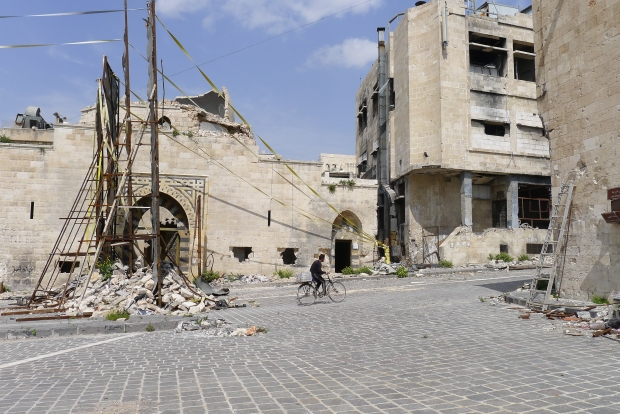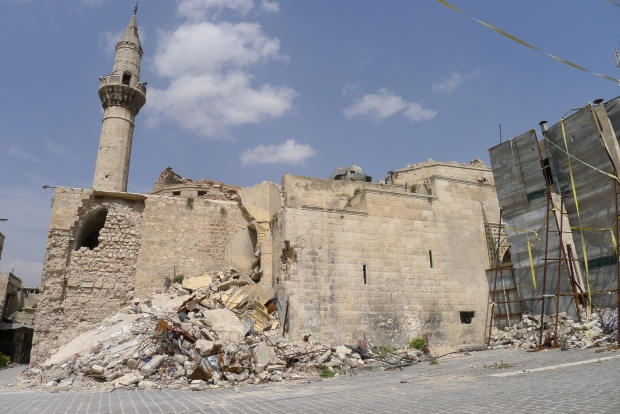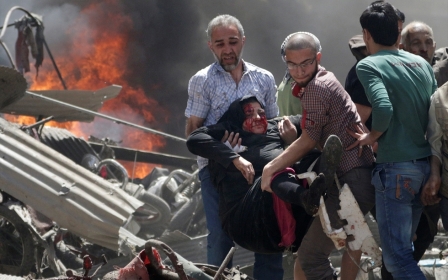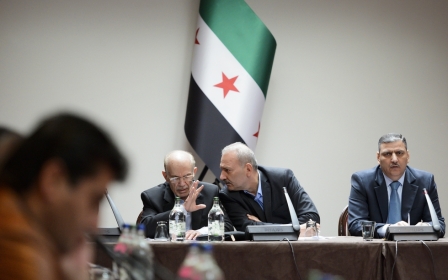Inside shattered Aleppo: 'You cannot imagine how beautiful it was before'
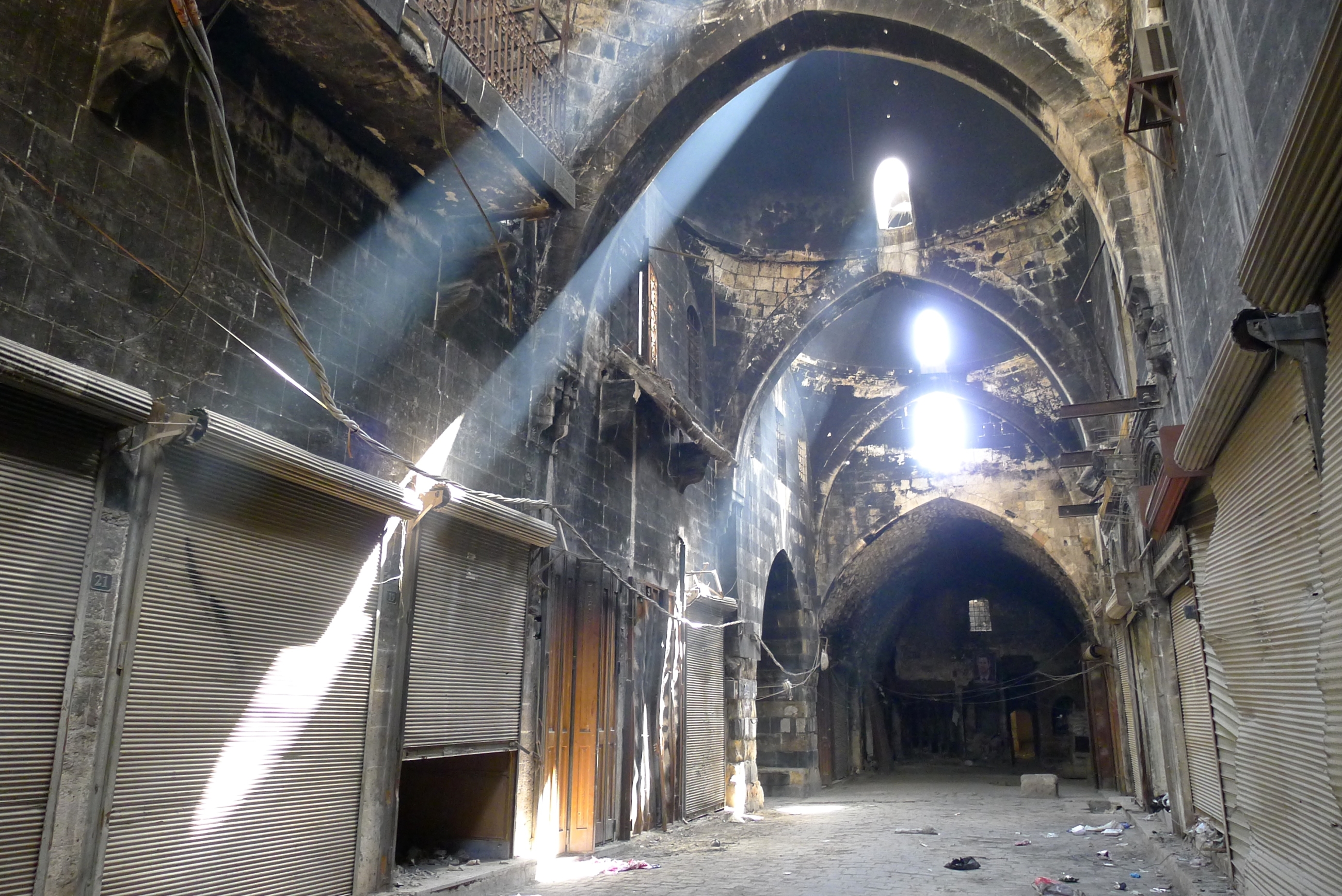
Middle East Eye travelled to Aleppo in a trip authorised by the Syrian government and was accompanied by an official minder.
In Aleppo’s ravaged historic souq, smoke drifts across shafts of light falling from high windows, illuminating the charred vaulted ceiling and a framed picture of Bashar al-Assad. Smoke and the occasional rattle of AK-47 fire is all that remains of a flurry of street fighting 15 minutes earlier, when opposition forces opened fire on a government army position.
For three-and-a-half years the once-bustling souq, part of the Old City of Aleppo UNESCO World Heritage Site, has been the scene of clashes between government troops and opposition forces.
The covered medieval market, the foundations of which date back to the second millennium BC, has been devastated by the conflict. Former workshops are burnt shells, shop fronts gape open - smashed wares poking through the rubble - and shutters are crumpled and peppered with bullet holes.
Former shopkeeper Mahmoud Memay's three shops where he sold handmade traditional musical instruments were destroyed by fire in 2012. He used to travel to craft fairs all over the world to showcase the wooden instruments - but now he has just 20 items preserved from a lifetime's work.
“How could I anticipate that I could lose everything in one single moment?” Memay asked, shaking his head as he stood behind the souq’s only functioning stall - a makeshift shop and takeaway. It stands in a silent, shuttered arcade, obscured from the sunlight by strips of fabric nailed between pillars to protect soldiers from the sights of snipers.
“The Syrian army were fighting the Free Syrian Amy in the main street right here and still I did not close.”
Wounded four times by shrapnel, he insisted he would never leave, even ignoring a visa sent to him from England by his brother. “Most merchants who had money left Syria or opened shops in other parts of the city. I have money but I love this country, especially the Old City, very much, and I will stay here,” he said.
Selling cigarettes and sandwiches, his customers - around 40 a day - are mainly government (SAA) soldiers and a few members of the 38 families who refused to leave their homes in the Old City. Women still hang out washing on balconies overlooking streets that remain under constant threat from snipers.
Others fled to safer districts of Aleppo. Mohamed Mardini lives with 33,000 other displaced Aleppo residents in former student accommodation in the grounds of Aleppo’s university, adapted into a centre for IDPs.
“When terrorists attacked the area, they started burning houses, forcing us to flee,” he said. Like many, he has no idea what happened to his home, which is in an area still under the control of opposition forces.
Outside the university housing blocks, now characterised by grey UNHCR tarpaulins hanging from balconies, a group of men gathered in front of a Syrian flag and a portrait of a young soldier - Amar Seraj Ali, 24 - killed fighting on the frontline outside the Islamic State-controlled town of Deir Ezzor, to offer condolences to his grieving family.
Locals said such funeral ceremonies were frequent, with most Syrian families having lost someone in the conflict.
Although the Syrian government does not release figures of the dead from its side, the UN estimated last year that 250,000 people had been killed in the five-year conflict; but Syrian envoy Staffan de Mistura last week said the toll was more likely 400,000.
“We offer our children for our country. We will redeem Syria with our souls,” said his father, Mohamed Seraj Ali, 59, his voice choked with tears. “It is our duty to defend our country. We have an elected president and we trust him very much.” Another of Ali’s sons has been missing since 2013.
The family think he was abducted by opposition forces for being a government employee. “I believe everyone should fight against terrorism and I believe this so strongly, I am prepared to fight until the very last member of my family is dead,” Ali said.
The Old City is one of several districts in Aleppo where the nationwide Syrian ceasefire brokered by Russia and America in February has proved to be fragile. All sides are accused of violating the truce.
Ceasefire exclusions have allowed the SAA to continue offensives against any opposition forces recognised as terrorist organisations by the UN Security Council, including IS and Syria’s al-Qaeda branch, al-Nusra Front.
Activists in rebel-held districts in the east and south of the city on Friday said that at least 25 people, most of them civilians, were killed when government forces pounded the areas with air strikes and barrel bombs.
Fighting in the Old City has decreased since the ceasefire was announced. But when the deputy commander of government forces in the area, Dia Dayoub Abu George, spoke to MEE, he described the calm as unusual, adding that the SAA expected “a storm to start any day".
He said 75 percent of the Old City had been under government control since 2013, but that attacks from opposition forces were ongoing.
“The terrorists still try to sneak in but we have a strong defence and they always withdraw,” said Abu George. Walking through the destruction lining the labyrinth of alleyways, he explained that the wreckage of the thousands of stalls that once comprised the 13 kilometre-long souq created a challenging battleground.
“The terrain presents many obstacles. The terrorists move men between the empty shops and suddenly one appears from a doorway and opens fire,” he said. “We have lost a lot of men here; there have been a lot of martyrs.”
As well as air strikes by government forces, random shelling by the rebels has continued. Earlier this month, a makeshift missile - a gas bottle attached to a mortar tube - hit the abandoned Swiss Consulate. In the rubble outside the building, spring flowers bloom on a tree that survived the blast, standing delicately beside two overturned cars.
Among ancient mosques with shattered domes, and buildings that have crumpled into the main thoroughfare through the souq, now barricaded by huge sniper defences made of corrugated iron, the air is full of birdsong intermittently disturbed by the sound of gunfire.
“You cannot imagine how beautiful this place was before,” one former resident said with a deep sigh. “It will take many years to rebuild.”
New MEE newsletter: Jerusalem Dispatch
Sign up to get the latest insights and analysis on Israel-Palestine, alongside Turkey Unpacked and other MEE newsletters
Middle East Eye delivers independent and unrivalled coverage and analysis of the Middle East, North Africa and beyond. To learn more about republishing this content and the associated fees, please fill out this form. More about MEE can be found here.



